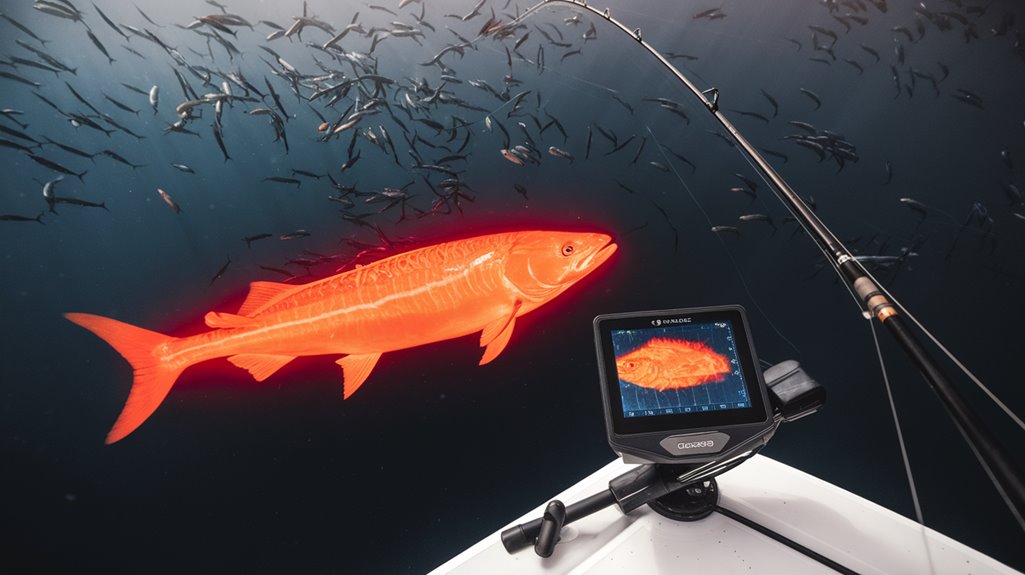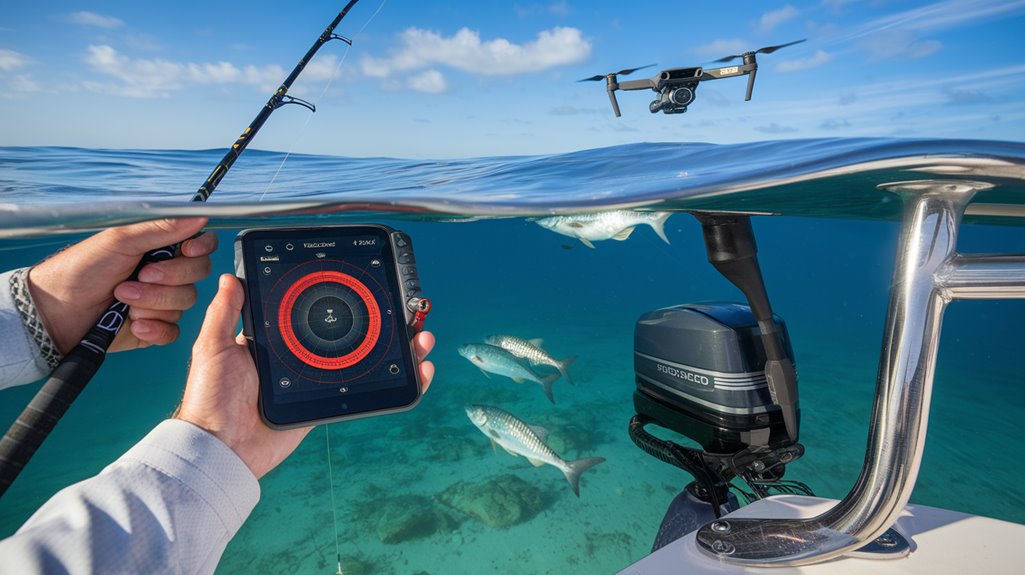Like the ancient mariners who navigated by starlight, you'll find that modern technology has transformed nighttime tarpon fishing into a precision art form. You're no longer limited by darkness when stalking these silver kings, thanks to cutting-edge night vision equipment and IR technology. While traditional anglers might struggle after sunset, you'll track rolling tarpon with military-grade accuracy and enhanced visibility. What you'll discover about targeting these magnificent fish under the cover of darkness will change your approach forever.
- Key Takeaways
- Night Vision Equipment: Revolutionizing Tarpon Fishing
- Essential Gear and Technical Setup
- Maximizing Your Field of View After Dark
- Targeting Techniques With IR Technology
- Strategic Approaches for Nocturnal Tarpon
- Best Practices for Night Vision Fishing Success
- Frequently Asked Questions
- Conclusion
Key Takeaways
- Night vision equipment with dual tube systems provides superior visibility for tracking Tarpon movements after dark.
- IR pointers and waterproof lights enhance target acquisition and improve coordination among fishing team members.
- Strategic positioning of lights and proper adjustment of night vision technology maximizes fish detection capabilities.
- 98-degree field of view combined with elevated mounting positions increases the ability to spot rolling Tarpon.
- Systematic scanning patterns and proper brightness settings optimize equipment performance across varying water conditions.
Night Vision Equipment: Revolutionizing Tarpon Fishing
How has night vision technology transformed the art of Tarpon fishing? Night vision equipment has revolutionized after-dark angling by providing unprecedented visibility that rivals daytime conditions. You'll experience superior visual clarity that lets you track rolling Tarpon and navigate your surroundings with confidence.
Whether you're using dual tube systems with their 40° field of view or advanced setups offering an expansive 98° range, you'll gain a significant tactical advantage on the water. When combined with military-grade waterproof lights featuring adjustable brightness and flash rates, your nighttime targeting abilities increase dramatically. While thermal options exist, they're ineffective for cold-blooded Tarpon. Instead, you'll want to rely on night vision technology paired with IR pointers and flashlights to precisely locate and track your target fish in the darkness.
Essential Gear and Technical Setup
A well-planned technical setup forms the foundation of successful nighttime Tarpon fishing. You'll need to properly adjust your night vision technology for ideal performance, ensuring a secure fit that won't compromise your 98° field of view. Mount your waterproof lights strategically, positioning them to maximize visibility while minimizing glare that could affect your night vision equipment.
Your technical arsenal should include IR pointers and flashlights with adjustable settings, allowing you to mark targets precisely for your team members. Configure your lighting system's brightness and flash rates to match your fishing conditions and target identification needs. When setting up your gear, position your equipment to facilitate smooth shifts between casting jerk baits, mullet, and crabs as you track rolling fish in the darkness.
Maximizing Your Field of View After Dark
You'll maximize your night vision coverage by mounting your dual tube equipment at eye level while keeping IR pointers within easy reach for quick target acquisition. To enhance your field of view beyond the standard 40°, position yourself slightly elevated and implement a systematic scanning pattern that covers overlapping sections of water. Your ability to spot rolling Tarpon will improve considerably when you combine proper equipment positioning with advanced vision enhancement techniques, such as adjusting brightness settings for varying water conditions.
Optimal Equipment Positioning
When setting up night vision equipment for tarpon fishing, strategic positioning becomes crucial for maximizing your field of view in dark conditions. To optimize your setup, consider the following placement strategies:
- Mount dual tube night vision gear at the helm to maintain a clear 40° view of your primary fishing zone while keeping your hands free for navigation
- Install waterproof lights with adjustable brightness around the boat's perimeter, focusing on key fishing areas without creating excessive glare
- Position IR pointers within arm's reach of team members to enable quick target identification and communication
- Verify night vision equipment is secured yet easily accessible, allowing for rapid adjustment when tracking rolling or jumping tarpon across your expanded 98° field of view
Vision Enhancement Techniques
Modern night vision technology has revolutionized after-dark tarpon fishing by expanding anglers' natural field of view to an impressive 98° coverage area. You'll find that dual tube setups offer a standard 40° view, while advanced systems provide even broader visibility for thorough scanning of your fishing grounds.
When you're tracking tarpon at night, you'll want to utilize waterproof lights with adjustable brightness settings for ideal illumination. While thermal goggles might seem appealing, they won't help you spot cold-blooded tarpon effectively. Instead, equip your boat with IR pointers and flashlights to enhance targeting precision and improve communication with your fishing partners. The right night vision technology lets you observe vital tarpon behavior, like jumping and rolling, with remarkable clarity – a game-changing advantage for successful nighttime angling.
Scanning Pattern Strategies
Maximizing your field of view requires a systematic scanning approach that builds upon your night vision equipment's capabilities. Whether you're working with a 40° dual tube setup or a 98° enhanced system, your success in tarpon fishing depends on implementing efficient scanning patterns.
To optimize your nighttime viewing strategy:
- Sweep methodically from left to right, maintaining a steady pace that allows you to detect subtle movement
- Use infrared pointers to mark specific locations where you've spotted rolling tarpon
- Adjust your scanning height and depth based on observed fish behavior patterns
- Modify your search area frequently as fish relocate throughout the night
Targeting Techniques With IR Technology

As night fishing technology continues to evolve, infrared (IR) equipment has revolutionized tarpon targeting techniques. You'll find that IR pointers and flashlights dramatically improve your ability to spot rolling tarpon in darkness, while IR lasers help coordinate positioning with other anglers on your boat.
Strategic Approaches for Nocturnal Tarpon
Building upon IR technology's advantages, strategic night fishing for tarpon requires precise timing and tactical refinement. When targeting these powerful gamefish after dark, you'll need to maximize your effectiveness by focusing on peak activity periods, particularly the final hour of daylight and pre-dawn moments.
For ideal night fishing success:
- Deploy dual tube night vision equipment to achieve a 98° scanning range, enabling you to spot rolling tarpon effectively
- Position your casts where you observe jumping and rolling activity, using jerk baits, mullet, or crabs
- Utilize waterproof lights with adjustable brightness settings to attract and concentrate fish in your target area
- Monitor and adapt to tarpon behavior patterns, adjusting your presentation based on their responses to different baits and techniques
Best Practices for Night Vision Fishing Success
Whether you're a seasoned angler or new to night fishing, mastering night vision equipment revolutionizes your tarpon fishing success. Your 98° field of view enhances target acquisition while IR pointers enable precise communication with fellow anglers. Combine these tools with waterproof lighting systems to maximize your effectiveness on the water.
| Equipment Type | Primary Function | Key Benefit |
|---|---|---|
| Military-Grade NV | Wide Field Scanning | Enhanced Detection |
| Waterproof Lights | Area Illumination | Fish Attraction |
| IR Pointers | Target Marking | Team Communication |
Time your expeditions during peak activity periods, particularly the magical last hour of daylight and pre-sunrise. Watch for tarpon's distinctive rolling and jumping behaviors through your night vision equipment, adjusting your casting strategy accordingly. This technological advantage transforms challenging nocturnal conditions into prime fishing opportunities.
Frequently Asked Questions
What Technology Is Used in the Fishing Industry?
You'll find advanced sonar, GPS navigation, high-definition fish finders, camera-equipped drones, and smart fishing rods with integrated sensors being used throughout today's technologically advanced fishing industry.
Why Is Tarpon Fishing Illegal?
You'll find tarpon fishing isn't entirely illegal, but it's strictly regulated to protect their vulnerable populations. During specific seasons, regulations enforce catch-and-release practices to guarantee these game fish's long-term survival.
What Is the Best Setup for Tarpon Fishing?
You'll need a medium-heavy rod, paired with a high-speed reel. Use 50-80lb braided line, and don't forget your circle hooks. Live mullet or crabs make perfect bait choices.
Why Are Tarpon so Hard to Hook?
You'll find tarpon difficult to hook because of their bony, armor-like mouths, acrobatic jumping behavior, powerful head-shaking abilities, and natural wariness. Their size and strength further complicate successful hook sets.
Conclusion
You'll find that incorporating night vision technology into your tarpon fishing arsenal can increase your success rate by up to 40% during peak nocturnal hours. By leveraging dual-tube systems and IR pointers, you're able to track rolling tarpon with military-grade precision. Remember to calibrate your equipment before each outing and maintain ideal battery levels for uninterrupted performance throughout your nighttime expedition.

